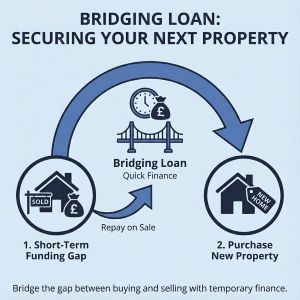Bridging Loan - £50K to £50M

Looking to invest in a commercial property? Read our complete guide on commercial mortgages and get the help you need to make an informed decision. If you need any help along the way, don't hesitate to contact us.
What is a Bridging Loan?
A bridging loan is a short-term property finance solution that helps bridge the financial gap between buying a new property and selling an existing one. It offers fast access to funds when timing is critical and is commonly used when traditional mortgages are not suitable due to delays or complex transaction chains.
This type of financing is beneficial for property sales, auction purchases, or refinancing. If you need quick capital for a purchase or project, a bridging loan may provide the speed and flexibility you need.
Common Bridging Loan Uses
Bridging finance is a flexible product used across a range of scenarios, including:
- Buying a property before completing the sale of your current home
- Securing funds for time-sensitive investment property opportunities
- Financing auction property purchases with tight deadlines
- Covering urgent expenses or refurbishment costs
- Managing property chain breaks in residential transactions
Need to fund a property project quickly? Learn more about property development finance and how it compares to bridging options.
Types of Bridging Loans
Open Bridging Loans
- Designed for borrowers who do not yet have a fixed exit strategy
- No fixed repayment date, offering maximum flexibility
- Typically used when funds are expected but not yet guaranteed
- Secured against residential or commercial property
- Usually have higher interest rates due to increased risk
Explore how commercial bridging finance may suit more complex transactions.
Closed Bridging Loans
- Suitable for borrowers with a clear and documented repayment plan
- A fixed repayment date is agreed in advance, often aligned with a property sale
- Lower interest rates due to reduced risk
- Ideal for chain-completion, refinance, or known income inflow
Want to understand if this type of finance fits your plans? Speak to a qualified adviser through our Contact Us page.
Is a Bridging Loan Right for You?
Bridging loans can be highly effective for fast-moving transactions. However, it is essential to assess affordability, fees, and exit strategies before committing. We recommend speaking with a qualified mortgage adviser to explore regulated and unregulated options tailored to your needs.
Learn more about regulated bridging loans and how they may apply to personal property purchases.
Bridging Loan Overview
| Loan Amount: | Loan Term: | Interest Rate: | Lenders: |
|---|---|---|---|
| £50K to £50M | 1 – 24 Months | Customized for Individual Loans | Whole of Market |
How Does a Bridging Loan Work?
Bridging loans are an excellent solution for filling a temporary financial gap. They come in handy when you need to borrow money for a short period. These types of loans are ideal for time-sensitive transactions (such as auctions) or when you’re purchasing a new home before selling your current one.
Let’s take a closer look at how a typical bridging loan operates:
Step 1:
After spotting a house in an auction with great potential for refurbishment and subsequent profitable resale, you've set aside £75,000 to invest. However, it's important to note that the auction's reserve price is £250,000.
Step 2:
Your next step involves evaluating the property's renovation requirements, which are estimated to cost £100,000. Upon completion of the refurbishment, the property's value is expected to soar to £500,000.
Step 3:
At this stage, you have the option to approach a bridging company for assistance in acquiring the property and financing the renovation expenses.
Step 4:
After completing the renovation, you have two options: sell the property, settle the bridging company's debt, and keep the profit, or refinance the property, clear the bridging company's debt, and lease it for a monthly income.
Alternatives to a Bridging Loan
Bridging loans are helpful for short-term property needs, but they’re not always the best fit for every situation. Depending on your goals, other finance options may offer lower costs or better long-term value. Below are a few regulated and widely used alternatives to consider.
Let-to-Buy Mortgage
If you want to buy a new home without selling your current one first, a let-to-buy mortgage could be a better option. It allows you to release equity from your existing property and use the rental income to support your new mortgage application. This avoids the urgency of a bridge loan while keeping both properties under control.
→ Read more about our let-to-buy mortgage advice
Second Charge Mortgage
A second charge mortgage lets you borrow against the equity in your current home without changing your existing mortgage. It’s often used to raise funds for home improvements or time-sensitive purchases and may offer lower interest rates than bridging finance.
→ Learn about how a second-charge loan could work for you
Remortgaging to Release Equity
If time permits, remortgaging your property to release equity can provide funds for a deposit or purchase. This approach spreads the cost over a longer term and avoids the higher interest rates typical of short-term loans.
→ Explore our remortgage options for residential or investment properties
Development Finance
For major renovations or property builds, development finance is often more suitable than a bridging loan. It’s structured to support staged fund releases as the work progresses. This option can work well for experienced developers who need larger loan amounts for phased construction.
→ Discover tailored development finance solutions
Which Option Is Right for You?
Every property scenario is different. Our team of qualified advisers can explain the pros and cons of each solution, helping you choose the most cost-effective and suitable option. All advice is tailored, transparent, and regulated by the Financial Conduct Authority.
→ Speak with a mortgage expert to compare your options
Bridging loan examples
Bridging Loan for Purchasing a New Property
aka: Chain Break Bridge
“..Tom has successfully exchanged contracts with the seller of his new property, but his purchaser’s solicitor requires additional time to fulfil a mortgage condition. As the agreed-upon completion date for purchasing the vendor’s property is rapidly approaching, Tom finds himself in an urgent situation. To fulfil his obligation to buy the new property while his current home is still on the market, Tom requires a bridging loan. The loan will be promptly repaid once his existing property is sold, resolving the temporary financial gap in the process..”
Bridging Loan for Renovation
aka: Renovation Bridge
“..In the process of renovating a buy-to-let property, Joanne finds herself in need of additional funds to cover the renovation costs. To address this financial requirement, she decides to apply for a bridging loan.
Once the renovation work is completed, Joanne plans to repay the loan either by selling the property or by remortgaging it, ensuring a smooth resolution of her financial obligations...”
Faster House Purchase
aka: Auction Bridge
“..After successfully purchasing a property at an auction, John faces the urgency of obtaining rapid financing. Traditional lenders are unable to process a mortgage within the necessary timeframe, leading him to choose a bridging loan as an alternative solution. Following the purchase, John plans to secure a long-term lender, allowing him to repay the bridging loan effectively and achieve a seamless financial transition...”
Investor Cash Buyer
aka: Drawdown Bridge
“..Dawn aims to swiftly acquire investment properties but requires additional available cash. To address this, she establishes a pre-approved drawdown bridge, utilising the equity in her current properties. This enables her to promptly secure new properties without the delays associated with a traditional mortgage. Subsequently, Dawn can remortgage the acquired property, using the funds to repay the bridge loan, thereby preparing herself for future property purchases...”
What next?
We will come back to you quickly to let you know how we can help. If you would like to speak to us immediately, call us on 01708 676 111.
Looking for our intermediaries site?
Mortgage Advice..
Thinking of getting a mortgage? Our experienced team of skilled mortgage advisers are here to offer the essential guidance you require. Relying on our comprehensive understanding of the mortgage market, we’ll ensure you secure the perfect mortgage to suit your specific situation.
Mortgage Advice..
Thinking of getting a mortgage? Our experienced team of skilled mortgage advisers are here to offer the essential guidance you require. Relying on our comprehensive understanding of the mortgage market, we’ll ensure you secure the perfect mortgage to suit your specific situation.
Liz Syms is the CEO and Founder of Connect Mortgages, a specialist in finance for property investment. With over 25 years of experience in mortgages and financial services, Liz has helped countless people get their dream homes and investment properties. She is passionate about giving her clients the best advice possible when it comes to financial decisions relating to mortgages and protection and is dedicated to providing the highest quality of service. With her wealth of knowledge in the industry, Liz is a respected leader in mortgages and financial services and has grown her team to over 300 advisers nationally. She strives to make Connect Mortgages one of the most successful companies in its field.
About the Author
Liz Syms is the CEO and Founder of Connect Mortgages, a specialist in finance for property investment. With over 25 years of experience in mortgages and financial services, Liz has helped countless people get their dream homes and investment properties. She is passionate about giving her clients the best advice possible when it comes to financial decisions relating to mortgages and protection and is dedicated to providing the highest quality of service. With her wealth of knowledge in the industry, Liz is a respected leader in mortgages and financial services and has grown her team to over 300 advisers nationally. She strives to make Connect Mortgages one of the most successful companies in its field.

